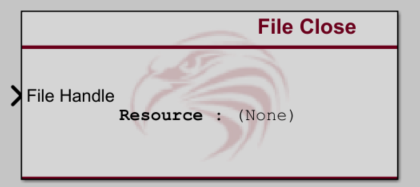Raptor:Data Logging File Close: Difference between revisions
(Created page with 'Return to the main Raptor page Return to File IO page [[File:RaptorDataLoggingFileClose.png|right|frame|Raptor™ Data Logging Fi…') |
No edit summary |
||
| (One intermediate revision by the same user not shown) | |||
| Line 6: | Line 6: | ||
== Description == | == Description == | ||
<p>This block | <p>This block will close a file, given the file handle and specified hardware on which the file is stored.</p> | ||
<p>Valid hardware resources vary, but typically include a connected USB storage device, and the modules built-in non-volatile data flash memory.</p> | |||
<p>When writing to a file, application designers should ensure that log files are closed using Raptor File Close blocks after each file write operation. This can help prevent memory overflows and corruption of log files.</p> | |||
<p>As with many of the other datalogging and file I/O Raptor blocks, this block takes a file handle as an input, and propagates the same file handle through the block logic to an output of the block. By connecting the File Handle output of file I/O block 'X' to the File Handle input of file I/O block 'Y', application designers can ensure that the logic executed by block Y will be performed after the logic executed by block X.</p> | |||
== Inputs == | == Inputs == | ||
| Line 18: | Line 24: | ||
| File Handle | | File Handle | ||
| Specifies the file to be closed. | | Specifies the file to be closed. | ||
|} | |} | ||
Latest revision as of 20:33, 12 September 2023
Return to the main Raptor page

Description
This block will close a file, given the file handle and specified hardware on which the file is stored.
Valid hardware resources vary, but typically include a connected USB storage device, and the modules built-in non-volatile data flash memory.
When writing to a file, application designers should ensure that log files are closed using Raptor File Close blocks after each file write operation. This can help prevent memory overflows and corruption of log files.
As with many of the other datalogging and file I/O Raptor blocks, this block takes a file handle as an input, and propagates the same file handle through the block logic to an output of the block. By connecting the File Handle output of file I/O block 'X' to the File Handle input of file I/O block 'Y', application designers can ensure that the logic executed by block Y will be performed after the logic executed by block X.
Inputs
| Input | Type | Description |
|---|---|---|
| File Handle | File Handle | Specifies the file to be closed. |
Parameters
| Parameter | Type | Description |
|---|---|---|
| Resource | Specify the resource which contains the file to close. |